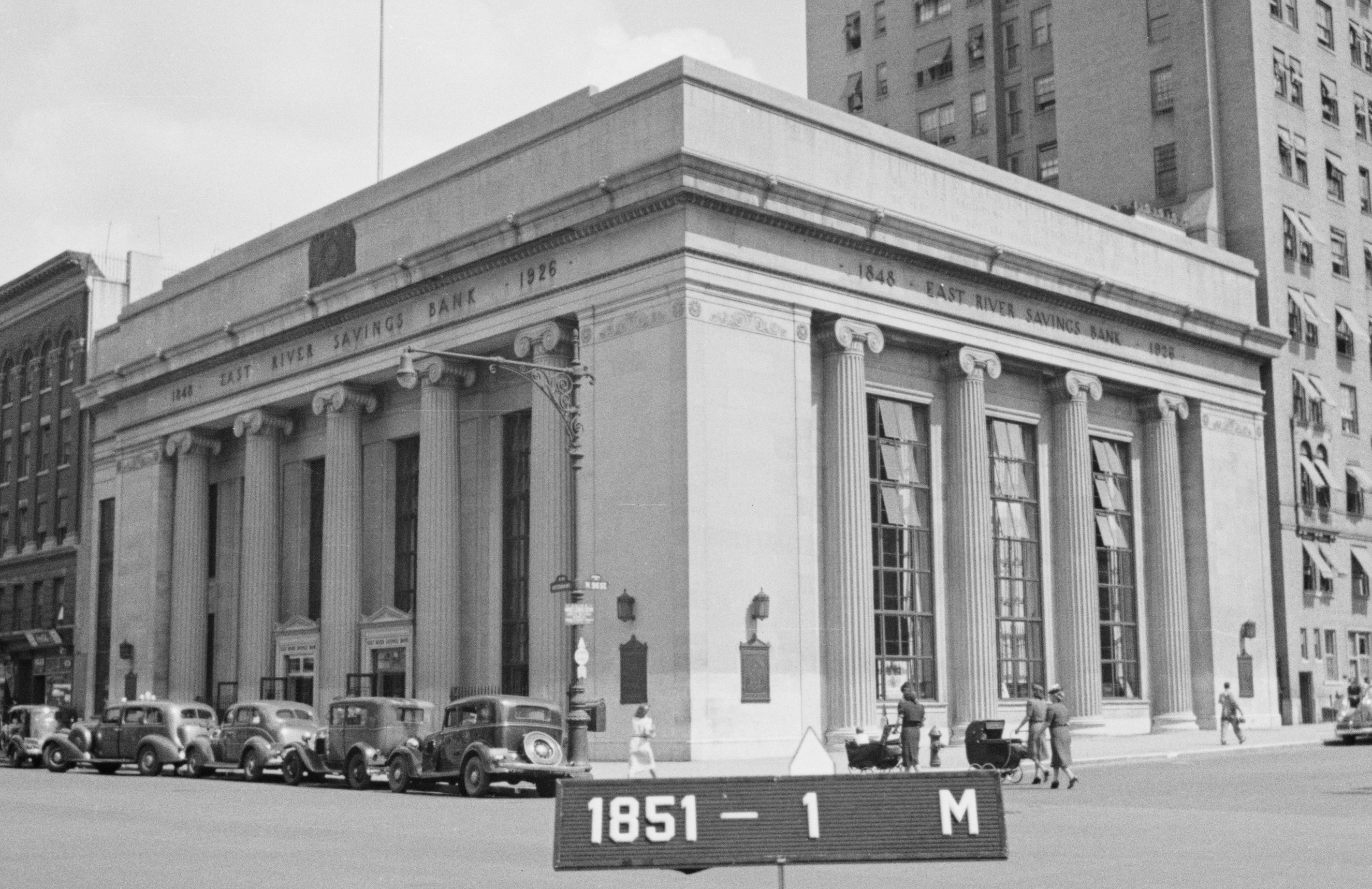
East River Savings Bank: 743 Amsterdam Avenue
by Tom Miller
John Leveridge was a prominent attorney in 1848. His law offices were conveniently located in his row house at 145 Cherry Street, one block from the East River. What was not convenient, however, was the lack of banking in the neighborhood.
To resolve the problem, Leveridge founded the East River Savings Institution, named after the nearby waterway. On opening day Irish immigrant Mary Linny strode into Leveridge’s office, which now doubled as the bank, with perhaps a little trepidation. Mary, who worked as a domestic servant, did what until a month ago was unthinkable. She opened a bank account.
Until the passage of the Married Women’s Property Act bank accounts in a woman’s name were illegal. The bank was the first savings bank to offer women the right to control their own funds deposited by them.
Mary Linny became not only one of the first clients of the East River Savings Institution; she broke ground as one of the first women in New York State to open a bank account.
The bank remained in Leveridge’s row house until 1851 when it moved to Chatham Square. Only two years later its growth demanded new space at 3 Chambers Street with deposits now topping $1 million. While other banks failed in the great Financial Panic of 1873, the East River Savings Institution survived and by 1895, deposits totaled more than $10 million.
Mary Linny became not only one of the first clients of the East River Savings Institution; she broke ground as one of the first women in New York State to open a bank account.
In 1923, after the bank had moved two more times, a law permitting branch banks for savings institutions was passed. The bank moved swiftly. Two years later, it purchased two tenement houses at the northeast corner of Amsterdam Avenue and West 96th Street. The same year the bank’s name officially changed to the East River Savings Bank.
The architectural firm of Walker & Gillette was commissioned to design the new building and plans were filed that fall. The company best known for residential designs – mansions and apartment buildings—however following the world war it received a series of bank commissions.
The tenement buildings were demolished in May 1925 and construction began. By the time of its completion on February 8, 1927, the new building would cost $265,000.
Bank architecture had, for the most part, taken on monumental qualities following the financial panics of the late 19th century. Most depositors in savings banks had little or no money that they could afford to lose. Earlier The Architectural Record had stressed, “The effect of the structure must be one of great importance and simplicity. It must make on the depositors the impression of being a perfectly safe place to leave their money and valuables.”
Walker & Gillette managed to do just that. While Art Deco was shaping the look of Midtown buildings, the new branch would echo the classic temple design to which customers had become accustomed. An Ionic portico of two immense columns faced the avenue while an imposing colonnade stretched along West 96th Street. Rather than imitate the more expected Roman protocol in which the columns would sit on stately pedestals; the architects sat them squarely on the sidewalk in the Greek fashion.
Double-height windows separated the engaged columns of 96th Street, hinting at the soaring space inside. Above a hefty entablature hid the penthouse floor of the bank offices. It was a limestone and marble temple to savings and thrift.
The branch opened with little fanfare on March 5, 1927. Despite the onslaught of the Great Depression two years later that crushed banks nationwide, the East River Savings Bank not only survived, but also grew. On April 12, 1931, The New York Times announced, “to provide additional facilities…the site occupied by two old five-story flats on the avenue adjoining the present bank building on the corner will be utilized for an addition to the building.” The bank at the time had over $118 million in resources.
Walker & Gillette was called in again. Construction began in June and completed the following year. The result was a seamless addition, dedicated on April 2, 1932, that doubled the size of the structure. Costing $530,000 the extension stretched northward along the avenue, adding three matching columns. Along the face of the parapet were carved quotations from Jefferson, “Save and teach all you are interested to save: Thus pave the way for moral and material success,” and from Lincoln, “Teach economy. That is one of the first and highest virtues. It begins with saving money.”
Things continued to go well for the bank, at lease for several decades. In 1932, it absorbed the Maiden Lane Savings Bank and the Italian Savings Bank of the City of New York—both banks founded to serve the immigrant community.
The branch provided the first major clue in the Lindbergh baby kidnapping case when detectives discovered a marked bill from the $50,000 ransom money deposited here. “On April 4, 1932, the police got their hands on the first of the ransom notes,” reported The Times. “It was a $5 red-seal note that had been put through the East River Savings Bank at Amsterdam Avenue and Ninety-Sixth Street.”
Detectives traced the bill to the depositor, got a description, and the groundwork was laid for the kidnappers’ capture three years later.
The branch provided the first major clue in the Lindbergh baby kidnapping case when detectives discovered a marked bill from the $50,000 ransom money deposited here.
The 1930s was a time before Plexiglas teller windows and armed security guards. Tellers often carried their own firearms not just to protect the bank, but for their own safety. John E. Nilsen was one of them.
On July 24, 1936 as the 30-year old teller was preparing to close down his cage, he emptied the bullets from his pistol. Around 4:15 pm, not realizing he had removed only five bullets from the .38-calibre weapon, he accidentally discharged it. The sixth bullet struck him in the right eye. The ten-year veteran of the bank tragically died two hours later.
Two decades later the country overcome with fears of nuclear bomb attacks, as global tensions increased. New Yorkers in 1951 instructed regarding home bomb shelters—what essentials they should contain, and how to create them from coal cellars, interior halls, etc. Two four-foot scale models of recommended home shelters constructed by the Port of New York Authority and displayed in the lobby of the East River Savings Bank.
The success of the bank had lasted over a century and a half. But by the 1970s, things started going downhill.
Home loans and multifamily loans dropped off as interest rates skyrocketed. When the bank acquired two savings and loans institutions, thereby taking advantage of new banking laws permitting S&L’s to invest five percent of their assets into real estate; it became attractive to real estate moguls. One purchased the bank, changing it to the River Bank of America.
Bad loans forced the Federal Deposit Insurance Corp. to issue a Cease and Desist order; and in 1995, the River Bank branches were sold to Marine Midland Bank. Within two years, Marine Midland decided to divest itself of the branch.
The New York Times joined the neighborhood in lamenting the move. “The Marine Midland Bank on the northeast corner of Amsterdam Avenue and Ninety-Sixth Street is the sort of solid, stately presence that nearby residents have come to assume is permanent.”
The noble financial monument sold in 1998. Before the year was up, it been renovated into a CVS Pharmacy, prompting the AIA Guide to New York City to comment, “Temple to cosmetics?”
Despite its retail use, the imposing granite bank retains its exterior grandeur. Little has changed outwardly in the “stately presence that nearby residents have come to assume is permanent.”
Tom Miller is a social historian and blogger at daytoninmanhattan.blogspot.com


